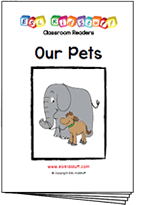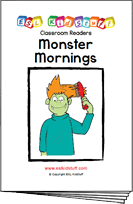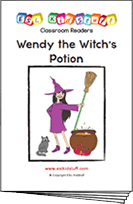Pets & possessions lesson plan
Stand-alone lesson ESL kids lesson plan
Lesson plans for ESL kids teachers

Pets & possessions
In this lesson students are introduced to pet vocabulary and the [hide_on_uk]verb[/hide_on_uk][hide_on_us]verbs[/hide_on_us] “[hide_on_uk]have[/hide_on_uk][hide_on_us]have got[/hide_on_us]” for possession / ownership. Numbers 1-10 are also reviewed. There is a song to sing and a classroom survey in which students ask each other about their pets and dream pets.
Members get accompanying flashcards, worksheets, song and classroom reader.
Download materials:
Our lesson plans are FREE!
Sign up for accompanying:
✔ worksheets
✔ homework sheets
✔ craft sheets
✔ flashcards
✔ song downloads & videos
✔ classroom readers & videos
Click to see lesson details, materials and supplies
Time: 40 mins – 1 hour
Objectives: Talking about different pets and possessions (using “[hide_on_uk]I have[/hide_on_uk][hide_on_us]I’ve got[/hide_on_us] …”).
Structures: “[hide_on_uk]Do you have[/hide_on_uk][hide_on_us]Have you got[/hide_on_us] any …?”, “I have …”, “Yes, I [hide_on_uk]do[/hide_on_uk][hide_on_us]have[/hide_on_us] / No, I [hide_on_uk]don’t[/hide_on_uk][hide_on_us]haven’t[/hide_on_us]”
Target vocabulary: pets, a dog, cats, hamsters, rabbits, goldfish, mouse/mice, turtles, parrots, horses, elephants, 1-10.
Lesson materials
Flashcards:
- dog, cat, hamster, rabbit, goldfish, mouse, turtle, parrot, horse, elephant
Printables:
- Your pets class survey worksheet
- My pet or My dream pet worksheets
- Reader worksheet
- [hide_on_uk]Do you have[/hide_on_uk][hide_on_us]Have you got[/hide_on_us] any pets? song poster
Songs:
- [hide_on_uk]Do you have[/hide_on_uk][hide_on_us]Have you got[/hide_on_us] any pets?, The numbers song (numbers 1-10)
Readers:
- Our pets
Additional materials:
- Pets and possessions vocab crossword
- Pets and possessions vocab word search
- Home sweet home worksheet
Supplies:
- [hide_on_uk]colored[/hide_on_uk][hide_on_us]coloured[/hide_on_us] pencils
- cards with numbers 1-10 written marker pen (enough sets so that each group of 3 or 4 students has a set of number cards)
- photos of your pets (even from years ago) if you have them. If not you can use flashcards instead
- Blu-Tack / tape (to stick flashcards onto the board)
- board with marker / chalk
- device to play the song on
This fun lesson covers three different objectives: Numbers 1-10 (review), pet vocabulary and using the [hide_on_uk]verb[/hide_on_uk][hide_on_us]verbs[/hide_on_us] “[hide_on_uk]have[/hide_on_uk][hide_on_us]have got[/hide_on_us]” for possession / ownership.
IMPORTANT:
You should have already taught the Numbers 1-10 lesson at some point before this lesson – these numbers will be reviewed in this lesson.
Lesson procedure:
Warm up and maintenance:
The beginning of your lesson is extremely important: this is where you set the tone of your lesson and get everyone in the right frame of mind for learning English. It is also an opportunity to check homework and review previous lessons.
Click for warm up suggestions for the start of your lessons
These activities can be done in the following order at the start of your lesson:

1. Greetings and name tags
Greet the students by name as they enter the classroom and gesture for them to sit down. Before class prepare some blank name tags (stickers or pin-on tags). Give these out and have everyone write their names and put their tags on. If you use pin-on tags, you can keep and give out every class.

2. Homework check
Check each student’s homework set in the last lesson. Ask each student some questions about their homework worksheet (e.g. “what [hide_on_uk]color[/hide_on_uk][hide_on_us]colour[/hide_on_us] is it?”), give lots of praise, and then put some kind of mark on the homework sheet (e.g. a sticker, a stamp or draw a smiley face). Finally, tell your students to put their homework back into their bags.
3. Review past lessons
Reviewing past lessons is very important – students need constant practice of new vocab, structures, songs, games and so on. Always review parts of your last lesson as well as some parts from other previous lessons. You can spend 5-10 minutes reviewing – it’s fine to recycle games and activities from your past lessons to review as kids enjoy playing familiar games (although be careful not to play a game to death!). See the section “Other ideas to include in your warm” below for ideas.
You can also include review activities in the main body of your lesson. Kids can have short attention spans so it’s good to be able to pull out lots of activities during different stages of the lesson.
Other ideas to include in your warm up:
Ball pass questions
This is good to review questions from previous lessons. Get everybody standing in a circle.

Round 1:
Take a ball and hold it and say, “My name is (you name)”. Then throw the ball to one student and say, “What’s your name?”. Students throw the ball around randomly, saying their names and asking for names.
Round 2:
This time ask a review question, e.g. “How many tables are there?”. Then throw the ball to a student who should answer, “There are (6) tables”. Help if necessary. Then that student throws the ball to another student and asks a “How many …?” question. Continue so everyone has a go. You can have multiple rounds with different topic questions.

Play “Spin the bottle”
Sit students in a circle with a bottle in the middle. Teacher spins the bottle. When it stops spinning the student it is pointing to has to answer a question. If the answer is correct then that student can spin the bottle. This is a good class warm up activity (e.g. How are you? What’s your [hide_on_uk]favorite[/hide_on_uk][hide_on_us]favourite[/hide_on_us] food? How’s the weather today?, etc.

Play “Vocabulary basketball”
This is a fun game which reviews vocabulary from previous lessons. You will need a basket (a trash can) and 2 balls (or 2 pieces of A4 paper scrunched up into balls).
Form 2 teams and line them up so that two players from each team are facing the front with the basket in front of them. Let both players throw their ball – if they get their ball into the basket they can try and win a point by giving the correct answer to a question the teacher asks. This can be an actual question (e.g. What are you wearing?) or a flashcard (What’s this?). Then they go to the back of the line. At the end, the team with the most points is the winner!
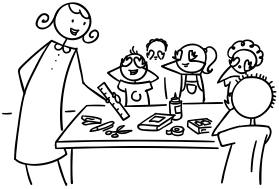
Play “What’s missing?”
This is a fun review memory game – students will have to try to remember review objects from previous lessons (e.g. classroom stationery). Lay the objects out on a table for all to see. Allow the students a minute to memorize the positions of the objects. Remove an object and hold it behind your back. Say, “Open your eyes!” – the first student who can shout out the missing object wins a point for his/her team. Play for all the objects.
Finally, calculate which team has won the most points and give them a round of applause.

Play “Quiz game show”
This is a fun quiz game, like a simple version of a TV game show. Draw some circles on the board and randomly write numbers 1, 2 or 3 in each circle. These will be points.
Put students into teams. Then ask the first team to choose a number – 1 is an easy question (e.g. “Do you like bananas?”) and 3 is a difficult question (e.g. point at a clock and ask, “What time is it?”). 2 will be in between in terms of difficulty. When the question has been answered correctly, erase that number circle. Play until all the number circles are gone – the team with the most points is the winner!

Read a classroom reader again
As you progress through the lessons you will start to build up a catalog of classroom readers (see our Readers download page at https://www.eslkidstuff.com). Kids love going back to old stories and reading through them again. Invite a student to pick a classroom reader and read through it as a class. Make the story as interactive as possible by asking questions (e.g. what [hide_on_uk]colors[/hide_on_uk][hide_on_us]colours[/hide_on_us] there are, the names of different objects, etc.) and getting students to speculate what is going to happen next in the story.

Talk about the weather (do after you have taught the weather lesson plan).
- Prepare a weather board. Before the first class prepare a piece of cardboard and cover it with felt – you are going to pin this to the wall. If you can, try and get blue felt (to represent the sky). Write at the top in large letters, “How’s the weather today?”. Below that write “Today it’s”. Cut out weather pictures (such as our weather flashcards) and stick some velcro on the back. Arrange the weather pictures around the edge of the board and then put the board on the wall of your classroom. You can now use this weather board at the beginning of every lesson.
- Ask about the weather. Ask, “How’s the weather today?” and have students put up their hands. Allow one weather condition per student (e.g. “It’s rainy”) and have each student come up and put a weather picture on the weather board.
- Introduce more weather vocabulary. Depending on weather conditions, you can introduce more weather words (with pictures … you can get students to draw them), such as:
- stormy
- misty
- showery
- freezing
- humid
- frosty
- icy
- drizzly
New learning and practice:
1. Review numbers 1-10
You should have taught the Numbers 1-10 lesson at some point before this lesson. Your students will be familiar with the numbers and this is a good time to review and have some numbers fun.
Before class, write each of the numbers 1 to 10 on cards in marker pen (so you’ll have a card with “1” written on it, another with “2”, and so on up to “10”). Prepare enough sets so that each group of 3 or 4 students has a set of number cards.
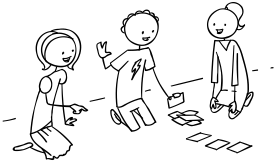
- Start by getting everyone to stand up and count in time with you the numbers 1 to 10, holding up fingers for each number. Start slowly and get faster and faster. You can even try some count down from 10 to 1.
- Next, play “Clusters”. Say, “Get into groups of 3!”. Everyone must grab someone and try and make a group of 3 people. Do this with lots of different numbers, although this will depend on the number of students in your class.
- Next, put your students into teams of 3 or 4. Give each group a set of number cards (explained above) and get each group to race putting them in the correct order.
- With the number cards on the desk/floor, tell your students to move them around so that they are shuffled well (but still face up). Give everyone 10 seconds to remember where the cards are. Now say, “Turn over the cards”. When everyone is ready say, “Ok, touch number 6”. Everyone must touch the card they think is number 6. Then allow them to turn the card over and check. Continue with all the other cards.
- Now collect up all of the number cards by having students race up and bring you different numbers.
- Finally, have everyone stand up and sing “The numbers song (numbers 1-10)” doing all of the actions.
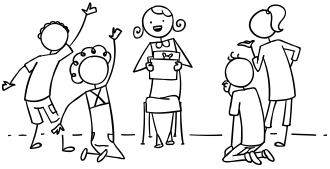
2. Teach the vocabulary for pets / animals
Before class, print off the flashcards for the animals (dog, cat, hamster, rabbit, goldfish, mouse, turtle, parrot, horse, elephant).
Your students will probably already know some of the animal vocabulary (e.g. cat and dog), so rather than just holding up each picture you can play “Flashcard reveal”: take the first flashcard and place it behind the pack of the other cards, so it is hidden from view. Slowly push the flashcard up so that the picture is revealed, bit by bit, to the class.
Encourage everyone to shout out what they think it is until someone gets the right answer. It is ok if students shout out the word in their language if they don’t know it – but make sure you teach the English word. Chorus each word three times and stick onto the board.
Once all of the cards are on the board, chorus them one more time. Then point to one picture and elicit the word, then write it clearly under the card.
NOTE: be sure to teach the plural for “mouse” –> “mice”.
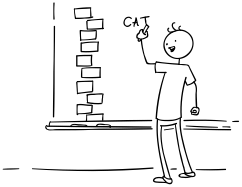
3. Play the “Write vocab on the board race” game
Put the class into teams, so you have 2 to 4 teams in total. Each team selects one person. Teacher shouts out the word for one of the animals on the board and one student from each team must rush up to the board, take a marker or chalk, and write the word (anywhere on the board is ok). The first person to write the word, spelt correctly, wins a point for his/her team. Continue playing until everyone has had a go and all the vocab has been practiced.
4. Teach the structures “[hide_on_uk]Do you have[/hide_on_uk][hide_on_us]Have you got[/hide_on_us] (any) …” and “[hide_on_uk]I have[/hide_on_uk][hide_on_us]I’ve got[/hide_on_us] …”
If you have any photos of your pets (even from years ago) it would be fun to bring them to class – show the photos to the class and as you do use the structure “[hide_on_uk]I have[/hide_on_uk][hide_on_us]I’ve got[/hide_on_us]” to say what pets you have (e.g. “[hide_on_uk]I have[/hide_on_uk][hide_on_us]I’ve got[/hide_on_us] a pet dog”). If not, no problem, we’ll just use the flashcards instead.
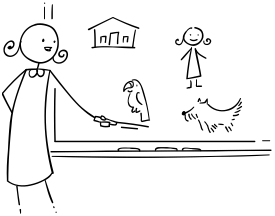
Point to a card and then point to yourself. Say, “[hide_on_uk]I have[/hide_on_uk][hide_on_us]I’ve got[/hide_on_us] a pet (dog). His/ Her name is …”. Draw a picture on the board of a house, a stick person (you) and the pet (a dog). Point to the stick person and say, “This is me”. Then point to the house and the animal and say, “This is my house”, “This is my pet dog, Momo” (for example). Maybe add a few of animals to the picture (e.g. a hamster, a parrot) to get the idea across. The point of this is to make clear that pets are animals we have at home (and not in the zoo, etc.).
Each time you add an animal to your picture, ask some students, “[hide_on_uk]Do you have[/hide_on_uk][hide_on_us]Have you got[/hide_on_us] a pet (dog)?” and elicit “Yes, I [hide_on_uk]do[/hide_on_uk][hide_on_us]have[/hide_on_us] / No, I [hide_on_uk]don’t[/hide_on_uk][hide_on_us]haven’t[/hide_on_us]”. If a student answers yes, ask what their pet’s name is. Depending on the level of your students, ask some other questions about their pets, such as if they are large or small, [hide_on_uk]colors[/hide_on_uk][hide_on_us]colours[/hide_on_us], [hide_on_uk]favorite[/hide_on_uk][hide_on_us]favourite[/hide_on_us] food, etc.
Finally, pick out some students at random, choose an animal from the cards on the board, and ask them if they have that pet (e.g. “[hide_on_uk]Do you have[/hide_on_uk][hide_on_us]Have you got[/hide_on_us] a pet mouse?”). The elephant is there for fun … don’t be surprised if students say they [hide_on_uk]have[/hide_on_uk][hide_on_us]have got[/hide_on_us] one – but look at them disbelievingly!
5. Play “Animal actions”
In this game students will practice the key structures and vocabulary.
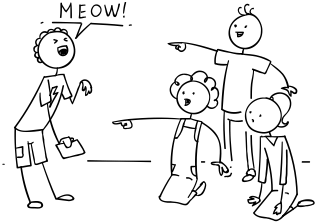
- If you have a large group (more than 10 students): invite 10 students to come to the front of the class and stand in a line facing the rest of the class. Give each of them one of the flashcards but don’t let anyone see what the picture is. They can each look at their own picture but mustn’t show it to anyone else.
The teacher starts by asking the first student, “[hide_on_uk]Do you have[/hide_on_uk][hide_on_us]Have you got[/hide_on_us] any pets?”. Encourage the student to reply, “Yes, I [hide_on_uk]do[/hide_on_uk][hide_on_us]have[/hide_on_us].” and then to do the action of the animal on his/her card (e.g. a cat meowing, and licking its paw, etc.).
Then ask, “[hide_on_uk]Do you have[/hide_on_uk][hide_on_us]Have you got[/hide_on_us] a cat?”. If correct, the student holds up the picture so everyone can see and says, “Yes, I [hide_on_uk]do[/hide_on_uk][hide_on_us]have[/hide_on_us]”.
Finally, invite members of the audience to ask the other students and guess what animal they [hide_on_uk]have[/hide_on_uk][hide_on_us]have got[/hide_on_us], using the correct structures. It is great fun to see the animal impersonations and to guess what it is!
- If you have a small group (less than 10 students): Give everyone one of the flashcards but don’t let anyone see what the picture is. They can each look at their own picture but mustn’t show it to anyone else.
The teacher starts by asking the first student, “[hide_on_uk]Do you have[/hide_on_uk][hide_on_us]Have you got[/hide_on_us] any pets?”. Encourage the student reply, “Yes, I [hide_on_uk]do[/hide_on_uk][hide_on_us]have[/hide_on_us].” and then to do the action of the animal on his/her card (e.g. a cat meowing, and licking its paw, etc.).
Then ask, “[hide_on_uk]Do you have[/hide_on_uk][hide_on_us]Have you got[/hide_on_us] a cat?”. If correct the student holds up the picture so everyone can see and says, “Yes, I [hide_on_uk]do[/hide_on_uk][hide_on_us]have[/hide_on_us].”.
Finally, invite other students to ask and guess what animal they [hide_on_uk]have[/hide_on_uk][hide_on_us]have got[/hide_on_us], using the correct structures. It is great fun to see the animal impersonations and to guess what it is!
6. Sing the “[hide_on_uk]Do you have[/hide_on_uk][hide_on_us]Have you got[/hide_on_us] any pets?” song
Get everyone to stand up. Make sure the flashcards are on the board in the order of the song, or alternatively, use the song poster. As the song is playing, have everyone march on the spot in time with the music and do the actions described below in the gestures section for the song. Play the song 2 or 3 times until everyone has got the hang of it.
Lyrics for “[hide_on_uk]Do you have[/hide_on_uk][hide_on_us]Have you got[/hide_on_us] any pets?”
Chorus:
[hide_on_uk]Do you, do you, do you[/hide_on_uk][hide_on_us]Have you, have you, have you[/hide_on_us]
[hide_on_uk]Do you have[/hide_on_uk][hide_on_us]Have you got[/hide_on_us] any pets?
[hide_on_uk]Do you, do you, do you[/hide_on_uk][hide_on_us]Have you, have you, have you[/hide_on_us]
[hide_on_uk]Do you have[/hide_on_uk][hide_on_us]Have you got[/hide_on_us] any pets?
Yes! Yes!
Verse 1:
[hide_on_uk]I have[/hide_on_uk][hide_on_us]I’ve got[/hide_on_us] a dog (a dog!)
[hide_on_uk]I have[/hide_on_uk][hide_on_us]I’ve got[/hide_on_us] 2 cats (2 cats!)
[hide_on_uk]I have[/hide_on_uk][hide_on_us]I’ve got[/hide_on_us] 3 hamsters (3 hamsters!)
[hide_on_uk]I have[/hide_on_uk][hide_on_us]I’ve got[/hide_on_us] 4 rabbits (4 rabbits!)
[hide_on_uk]I have[/hide_on_uk][hide_on_us]I’ve got[/hide_on_us] 5 goldfish (5 goldfish!)
Chorus
Verse 2:
[hide_on_uk]I have[/hide_on_uk][hide_on_us]I’ve got[/hide_on_us] 6 mice (6 mice!)
[hide_on_uk]I have[/hide_on_uk][hide_on_us]I’ve got[/hide_on_us] 7 turtles (7 turtles!)
[hide_on_uk]I have[/hide_on_uk][hide_on_us]I’ve got[/hide_on_us] 8 parrots (8 parrots!)
[hide_on_uk]I have[/hide_on_uk][hide_on_us]I’ve got[/hide_on_us] 9 horses (9 horses!)
[hide_on_uk]I have[/hide_on_uk][hide_on_us]I’ve got[/hide_on_us] 10 elephants! (10 elephants! No way!)
Chorus
Verse 3:
[hide_on_uk]I have[/hide_on_uk][hide_on_us]I’ve got[/hide_on_us]
a dog
2 cats
3 hamsters
4 rabbits
5 goldfish
6 mice
7 turtles
8 parrots
9 horses
and 10 elephants!
No way!
Gestures for “[hide_on_uk]Do you have[/hide_on_uk][hide_on_us]Have you got[/hide_on_us] any pets?”
The actions are very simple for this song:
- for the chorus, march along on the spot as you sing (it is a marching-style song)
- for the verses:
– Option 1: hold up your hands (fists closed) and count off the numbers with your fingers as you sing (whilst still marching).
– Option 2: print off the pets flashcards and stick around the classroom walls (in the order of the song). As you sing, point to each animal (whilst still marching).
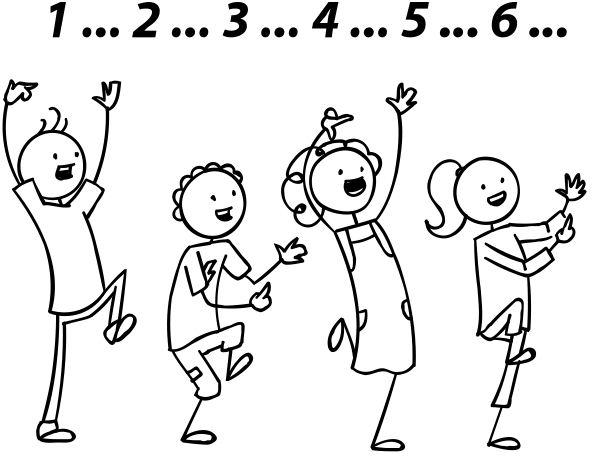
[hide_on_uk]Short sample (members get full-length song):
[/hide_on_uk]
[hide_on_us]Short sample (members get full-length song):
[/hide_on_us]
7. Read classroom reader “Our pets”
This reader follows on from the song and also leads nicely onto the next activity as it reinforces the animal vocabulary as well as the structures “[hide_on_uk]Do you have[/hide_on_uk][hide_on_us]Have you got[/hide_on_us] …?” and “[hide_on_uk]I have[/hide_on_uk][hide_on_us]I’ve got[/hide_on_us] …”.
Before class, download and print off the reader “Our pets”. As you go through each page elicit each animal and get everybody to guess/speculate which pet each animal has, for example:
Teacher: (on page 1) Look, what animal is this?
Students: Elephant!
Teacher: Yes, well done! … (reading) … “Hello, elephant! [hide_on_uk]Do you have[/hide_on_uk][hide_on_us]Have you got[/hide_on_us] any pets?” … Now, what do you think this is? (pointing at the hidden animal on page 1)
Students: Um … a dog? … a horse?
Teacher: Let’s see … (turns to page 2, reading) … “Yes, [hide_on_uk]I have[/hide_on_uk][hide_on_us]I’ve got[/hide_on_us] a pet horse”. A horse, very good!

Continue through the story, eliciting the vocabulary and getting everyone to guess what pet each animal has. Make sure the students are really involved in the story by asking lots of questions (e.g. asking students if they also have the same pets as the animals).
After reading the story, give out a reader worksheet to each student and read through the story one more time (without stopping for questions, etc.) as students draw lines to match the owners to their pets. Then go through the answers as a class.
Alternatively, watch our video version of the reader (Internet connection required).
8. Do the “Your pets class survey”
Give out the survey worksheets to each student. Model how to do the first line – by writing in their own names filling in their answers. Then get everyone to mingle and ask as many students as they can about their pets. For students who don’t have pets, we have added the “Which new pet would you like?” section, so they have something to answer … everyone can answer this even if they already have pets.
When everyone has finished, tally up on the board the number of pets everyone has to find out which is the most popular pet. Also, find out which new pet most people would like.
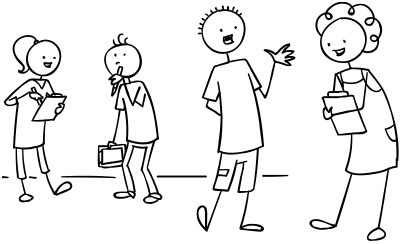
Wrap up:
Assign homework:
For homework, give out the “My pet” or “My dream pet” worksheets. A good idea is to give our the “My pet” worksheets to students who have pets and the “My dream pet” worksheets to students who don’t have any pets. It is worth giving a model answer to this writing task, giving information such as the pet’s name, age, size, [hide_on_uk]colors[/hide_on_uk][hide_on_us]colours[/hide_on_us], [hide_on_uk]favorite[/hide_on_uk][hide_on_us]favourite[/hide_on_us] foods, etc.
Click for wrap up suggestions for the end of your lessons

1. Assign homework
Each week give out a homework worksheet for your students to take home. Hold up the homework worksheet and model how to do it. Give out the worksheets and say, “Put your homework in your bags”.

2. Do “Quick check”
Time to leave the class. Make sure everything is put away and the students have gathered their belongings. Have them line up at the door and place yourself between the door and the students. For each student check one new word or phrase, for example:
- hold up an object or flashcard (such as an item of clothing) and ask, “What’s this?”
- ask a question from the lesson (e.g. “Where do you live?”, “Do you like bananas?”, “Can you play chess?”, etc.)
When they give you the correct answer say goodbye and let them leave. If their answer is wrong, have them go back to the end of the line – they will have to try again once they reach the front!
Other lesson plans
Actions, verbs & tenses:
- Can – for ability
- Morning routines
- Daily routines & times of the day
- Actions – Present continuous
- Future plans using “going to”
- Past tense activities – Regular verbs
- Past tense activities – Irregular verbs: Part 1
- Past tense activities – Irregular verbs: Part 2
Adjectives:
- Describing people
- Describing things
- Comparing things (Comparative adjectives)
- Comparing things (Superlative adjectives)
Adverbs:
Alphabet:
Animals:
Body:
Classroom:
Clothes:
Colors:
Colours:
Directions:
Family:
Feelings & emotions:
Food:
Health & sickness:
Holidays & festivals:
Jobs:
Likes, dislikes & favorites:
Likes, dislikes & favourites:
- Likes & dislikes
- [hide_on_uk]Favorites[/hide_on_uk][hide_on_us]Favourites[/hide_on_us] and asking why
Nature & Our world:
Numbers:
Places & where we live:
Prepositions of location:
Pronouns:
Shapes:
Shopping:
Sports:
Time, days, months, seasons:
Toys:
Transport & travel:
Weather:


